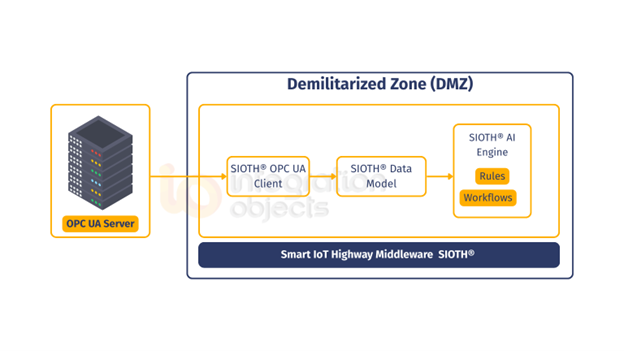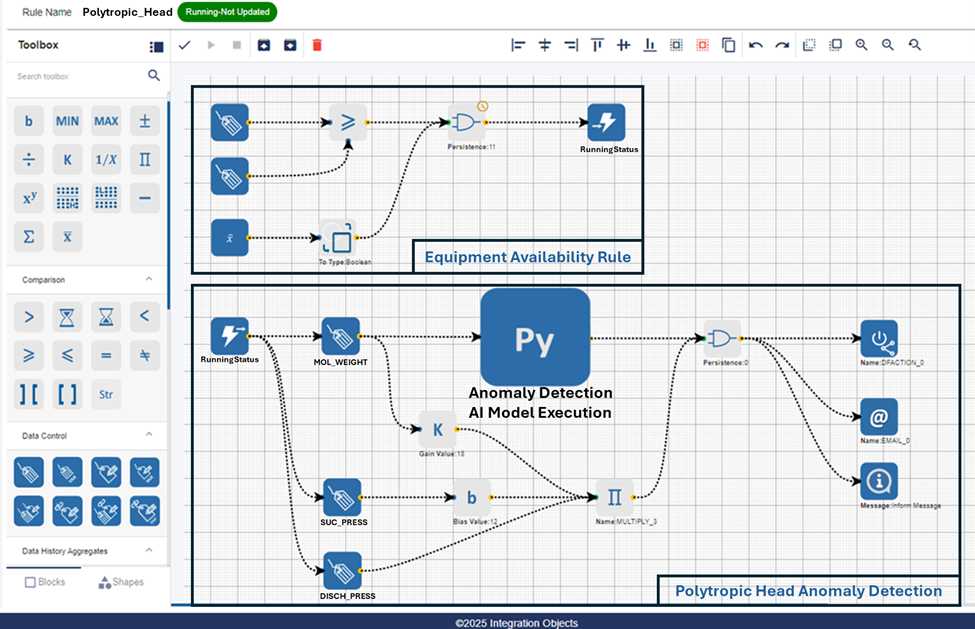SPONSORED BY: Integration Objects
Integrating OPC UA Data into AI and Machine Learning Workflows
The industrial landscape is undergoing a transformative shift. Sensors, PLCs, SCADA systems, and industrial controllers have all contributed to the decades-long production of enormous volumes of high value machine data. However, despite its potential, most of this data remains siloed, underutilized, or simply inaccessible to the tools that could unlock its full value.
This gap has become more apparent as artificial intelligence (AI) and machine learning (ML) have matured. These technologies thrive on data, especially the kind of rich, real-time information that Operational Technology (OT) systems produce. Use cases like assets predictive failure, quality assurance, and energy optimization aren’t theoretical anymore, they’re real, and they rely on accurate and timely data.
To fully harness these opportunities, organizations must find a simple way to integrate OT data into modern AI pipelines without compromising the integrity, structure, or semantics. This is where OPC UA (Open Platform Communications Unified Architecture) plays a critical role. As a vendor-neutral, platform independent standard, OPC UA enables secure and structured data exchange between OT devices and external systems, making it a foundational enabler for integrating industrial data into AI and machine learning workflows. OPC UA allows an easy way to expose OT data to external applications. However, bringing OPC UA data beyond the OT layer – whether to on-premises IT systems, cloud environments, or a hybrid of both – requires robust cybersecurity mechanisms to maintain proper segregation between OT, IT, and cloud networks.
This is where SIOTH® (Smart IoT Highway) comes in. Acting as an integration platform, SIOTH® enables the seamless and secure flow of OPC UA data into AI and machine learning environments. SIOTH® builds on OPC UA ecosystem’s strengths and makes it easier to orchestrate, transform, filter, and deliver high-quality industrial data into analytics platforms at scale.
Why OPC UA is the Perfect Data Source for AI
As industrial AI applications grow in complexity and scale, the quality of data becomes more critical than ever. Feeding AI models with inconsistent, incomplete, or poorly contextualized data often leads to unreliable results.
SIOTH® OPC UA offers a robust, standardized framework for secure and structured data exchange in industrial environments. However, to fully realize its potential for AI and machine learning, additional layers of data management – such as orchestration, transformation, and filtering – are often necessary. Solutions that build on SIOTH® can provide these enhancements, ensuring that AI models receive consistent, high-quality, and context-rich data.
By leveraging SIOTH® OPC UA alongside these complementary capabilities, organizations can better support reliable and scalable industrial AI initiatives.
Here’s why:
- Data Modeling
While OPC UA provides a foundational framework for structuring industrial data, it is often the enriched data models built on top of this foundation – such as those developed by platforms like SIOTH® – that transform raw OPC UA data into formats that are truly exploitable for AI. SIOTH®’s data model adds the necessary context, structure, and domain expertise that enable AI algorithms to better interpret and utilize the date, leading to improved accuracy and insights.
- Access to real-time and historical data
AI models often require a combination of real-time data (for immediate insights) and historical data (for training and trend analysis). While OPC UA supports access to both live signals and time-series data, it is the integration and enhancement capabilities provided by SIOTH® that enable seamless and efficient gathering, processing, and delivery of these assets. Together, they ensure AI systems receive the comprehensive data needed for effective analysis.
- Vendor-Agnostic Communication
As an open and standardized protocol, SIOTH® enables seamless communication across devices and systems from different manufacturers. When extending AI applications over several assets or sites, the interoperability ensures that data from diverse sources can be aggregated without the need for custom integration.
- Built-in Security Architecture:
OPC UA was designed with security in mind. It includes native support for encryption, authentication, user access control, and secure channel communication. These features help protect data integrity and confidentiality, making it a secure choice for exposing OT data to external systems like AI/ML platforms without introducing vulnerabilities into the OT environment.
These characteristics make OPC UA not just an industrial protocol, but a strategic facilitator of intelligent operations. The remaining piece of the puzzle is figuring out how to connect OPC UA with AI/ML systems without compromising the security of the OT network.
SIOTH®: the Smart IoT Highway for OPC UA-Driven AI
SIOTH® is an IT-OT-IIoT integration platform purpose-built to accelerate digital transformation in the OT landscape. The platform acts as a middleware layer that seamlessly connects OPC UA-enabled assets to cloud and edge-based AI environments, transforming raw industrial data into actionable intelligence.

SIOTH® for OPC UA Driven-AI
How SIOTH® Enables OPC UA for AI Applications
OPC UA’s secure, standardized, and information-rich data model lays the ideal foundation for AI in industrial environments. SIOTH® expands on this by providing a complete toolset that turns OPC UA data into real-time intelligence.
Here’s how:
- Support of DMZ based Architectures
SIOTH® enables secure data flow across segmented networks, supporting DMZ architectures that isolate OT, IT, and cloud environments. It acts as a controlled gateway, allowing OPC UA data to reach AI platforms without exposing critical assets.
With built-in support for multiple protocols like MQTT, Modbus, OPC DA, and REST, SIOTH® securely integrates diverse data sources using encrypted communication and strict access controls.
- Enhanced Data Modeling
SIOTH® incorporates a robust data modeling layer that builds upon raw OPC UA data, transforming and enriching it with additional context, structure, and semantics. This enhanced data model makes the information more interpretable and actionable for AI and machine learning applications, ensuring that algorithms receive data that is both meaningful and consistent. SIOTH® data modeling is uniquely flexible, allowing customization to specific industrial domains and applications, which ensures scalability and adaptability as AI initiatives evolve. This flexibility helps organizations manage complex data environments efficiently, accelerating AI deployment and improving overall data usability.
- AI-Ready Data Validation and Rule Engine
SIOTH® ensures that only contextually valid, high-integrity data is sent to AI and machine learning models. The rule engine allows users to model expert knowledge and apply complex logic around machine learning models, enabling fine-grained control over data filtering, validation, and management. This includes detecting missing or inconsistent values and formatting data appropriately for AI consumption. The rule engine is designed with usability in mind, offering an intuitive interface that empowers domain experts to implement complex data validation and control workflows without deep coding expertise. This ease of use significantly reduces deployment time and ensures robust, trustworthy data pipelines.
- Integrated AI and ML execution with SIOTH® Job Engine
SIOTH®’s job engine enables users to integrate and run machine learning models directly within the platform thanks to its native support for Python scripting. These models can consume live OPC UA data streams, making it possible to perform real-time data analysis and predictions without needing to move data off-platform. This direct integration eliminates latency, simplifies communications, and supports faster operational decisions.
With seamless access to live data streams and flexible scripting capabilities, SIOTH®’s job engine offers unmatched agility and performance for AI execution. This reduces complexity and enhances scalability compared to architectures requiring external data transfers or separate ML platforms.
- Predictive Analytics and Anomaly Detection
SIOTH® enables continuous monitoring of process variables by applying ML-driven models, analytics combined with rules to OPC UA data. It can detect deviations, anomalies, or early signs of failure and trigger notifications or actions accordingly. This proactive approach enhances asset reliability and reduces downtime, two core goals of industrial AI strategies.

Compressor Anomaly Detection
- Unified HMI for AI insights
SIOTH®’s Unified HMI presents AI-driven insights in intuitive, role-based dashboards. Operators and engineers can monitor equipment’s health, energy efficiency, predicted process deviations, and system performance, all derived from AI calculations. This visual layer helps bridge the gap between complex AI models and actionable human understanding.
- Automated AI Reporting
Beyond real-time monitoring, SIOTH® supports automated report generation that combines AI models outputs with OPC UA data. These reports help track performance improvement opportunities, identify patterns, and inform future optimization strategies, supporting both technical teams and business stakeholders.
SIOTH® with OPC UA data provides a solid foundation for industrial AI by offering structured, high-quality data with built-in context and interoperability. With SIOTH® platform, OPC UA data is collected in a secure way to become more accessible and actionable, enabling use cases like predictive maintenance, anomaly detection, and real-time optimization.
SIOTH® with OPC UA data helps bridge the gap between operational data and AI systems, supporting smarter, more responsive industrial operations.